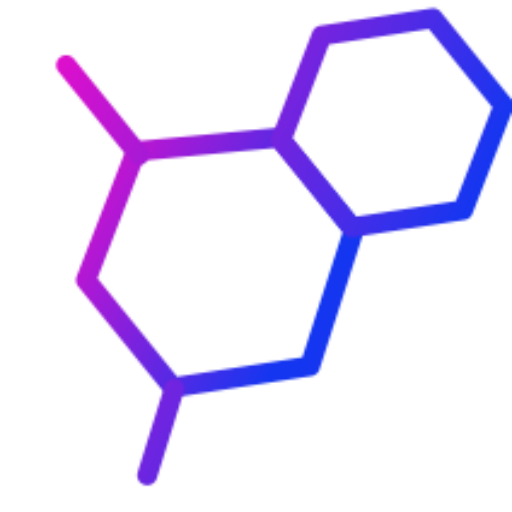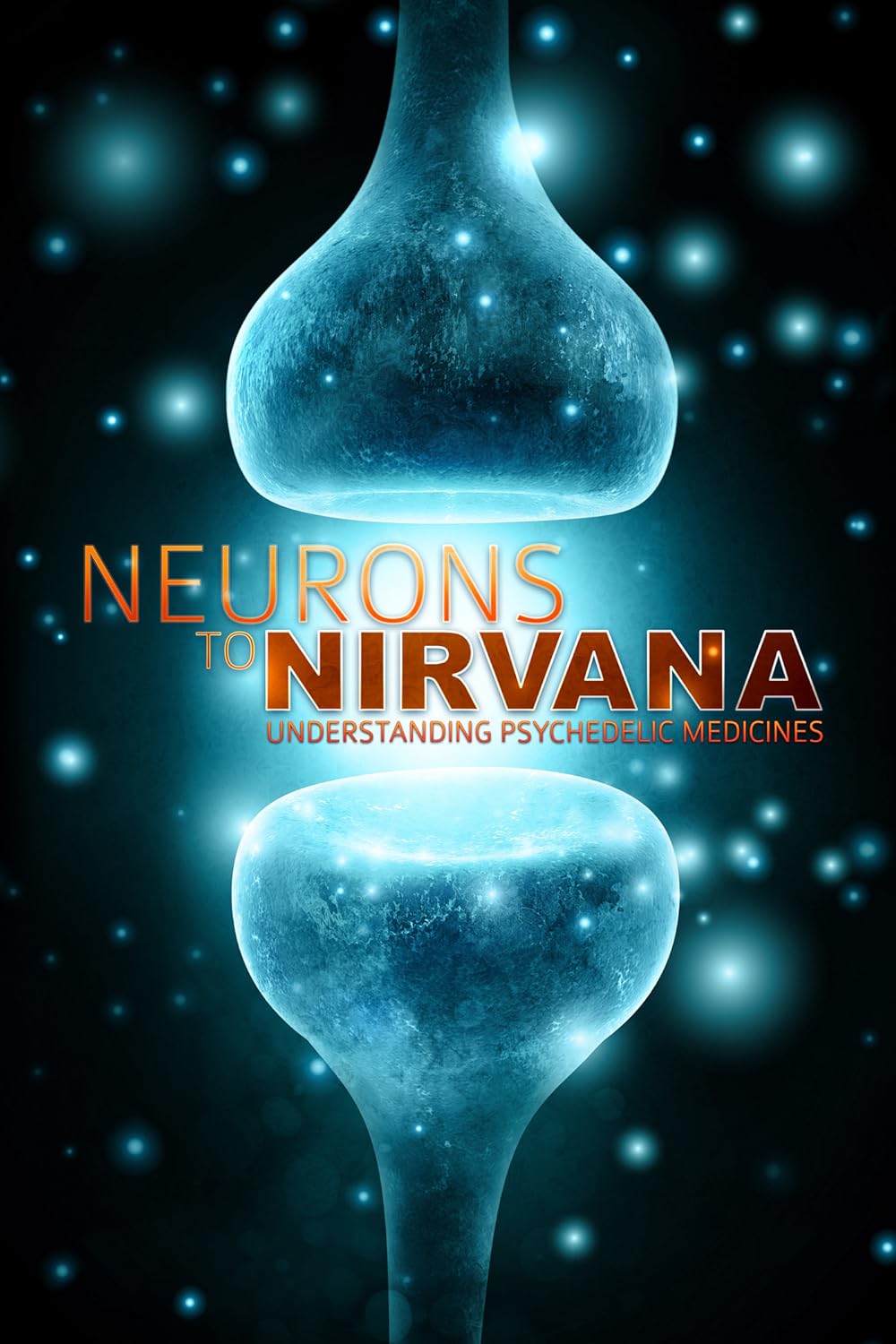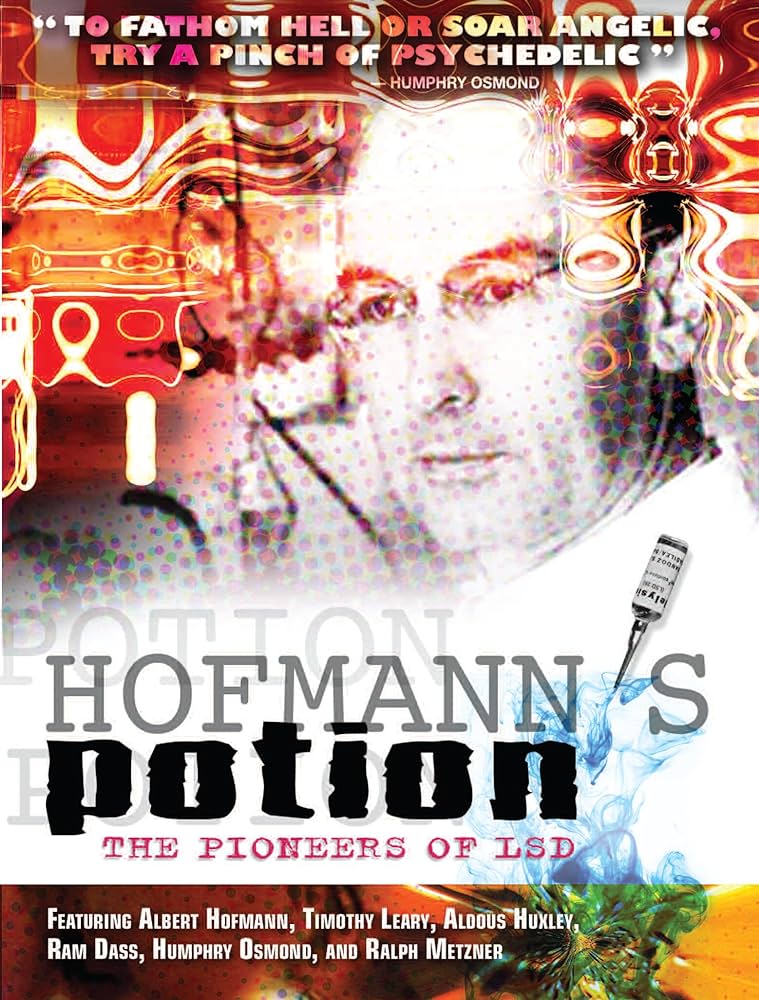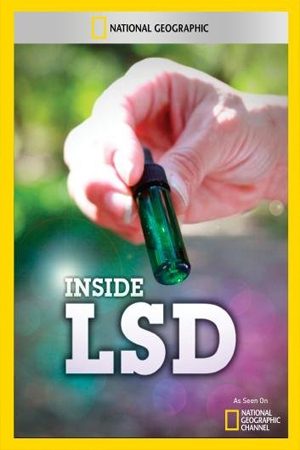DMT (dimethyltryptamine) is one of the most profound and well-known psychedelics on Earth.
This powerful psychedelic is surprisingly easy to make. The simplest method is to extract it from DMT-containing plants, but it can also be synthesized from commercially available ingredients with a rudimentary understanding of chemistry and access to fairly basic lab equipment.
In this guide, we’ll cover three distinct methods for making two kinds “DMT.”
We’ll cover the natural extraction method (beginner level), synthesizing 5-MeO-DMT Hamilton Morris style (intermediate level), and cover a method for making N,N,DMT (advanced level).
What is DMT?
DMT stands for dimethyltryptamine — it’s one of the simplest psychedelics from a molecular level — but among the most profound in terms of the experience it produces. There are a few different kinds of DMT, but the most common are N,N,DMT and 5-MeO-DMT.
Other forms exist as well but produce a very different experience — such as 4-AcO-DMT (more similar to psilocybin than DMT), 5-Bromo-DMT (very mild psychoactive effects), and 4-OH-DMT (the chemical name for psilocin). These compounds are technically a form of DMT, but are considered an entirely different class than N,N,DMT or 5-MeO-DMT.
The most common method of using DMT is in the form of ayahuasca (N,N,DMT) or the Bufo alvarius toad (5-MeO-DMT). Both are traditional sources of DMT used by shamans to occasion mystical experiences for the sake of healing and self-exploration.
DMT can also be smoked or vaped — inducing a powerful but short-lived psychedelic experience.
Studies have shown that DMT is able to reliably induce mystical experiences that offer value towards dislodging deep psychological traumas, confronting personal truths, and healing mental illness. DMT is being explored as a treatment for existential anxiety, depression, addiction, anxiety, migraine headaches, and much more.
How to Extract DMT From Plants
The easiest way to make DMT is to extract it from plants. The most common plant used is Mimosa hostilis root bark, which is readily available online. Most plant sources contain N,N,DMT rather than 5-MeO-DMT or other psychedelic tryptamines. There are other sources that can be used as well, such as Acacia confusa, Psychotria viridis, and much more.
You can run the extraction with simple materials sourced online or at big box stores.
Here’s the run-down:
Ingredients:
- DMT-containing plant material — you can use Mimosa hostilis, Mimosa pudica, Psychotria viridis, or other plant-sources of DMT
- A nonpolar solvent — such as naphtha (not recommended) DMT is very soluble to Chloroform
- Distilled water
- Sodium hydroxide (lye)
- 5% distilled white vinegar — can also use muriatic acid
Equipment:
- Nitrile gloves
- Safety goggles
- A pipette or separation funnel— to remove the nonpolar layer that contains the DMT (separation funnels work great too)
- Coffee filters
- A few glass beakers or jars — never use plastic or metal containers to perform these extractions
- A refrigerator and freezer
- A coffee grinder or blender
The Process: Simplified
- Mix plant material with vinegar and water
- Add sodium hydroxide to increase the pH
- Add solvent to separate the DMT portion
- Place the solution in the fridge to separate the DMT
- Filter and dry the freebase DMT powder
Step-By-Step Process for Extracting DMT From Plants
The basic process of isolating DMT from plant sources is simple and can be done using chemicals that are readily accessible without the need for a lab license. There are many different options for the chemicals used, and more advanced methods of purification like short-path vacuum distillation can make the process more efficient but aren’t entirely necessary.
The following process outlines the simplest method of DMT extraction anybody can follow at home.
The most important point to remember here is that despite being readily available, the chemicals used in this process are very dangerous if used incorrectly:
- Lye is caustic and can cause severe chemical burns to the eyes and skin — wear gloves and goggles.
- Naphtha and other solvents are highly flammable — ensure the area is well-ventilated and away from sparks or open flames.
- Some plants are toxic — always ensure the raw plant material is sourced from a reputable source to avoid extracting the wrong species of plant.
Here’s the step-by-step process for extracting DMT from plants — the simple method:
Step 1: Gently Heat the Plant Material in Water & Vinegar
Starting with your dried plant material, grind it into a fine powder using a blender or coffee grinder.
Next, slowly add 5% distilled white vinegar to the powdered herb (ratio 0.4 mL per gram of dried herb). Alternatively, you can use muriatic acid for this step.
Add near boiling distilled water (90ºC) at a ratio of 3.6 mL water to 1 gram of dried root powder.
Gently heat the solution for about 3 hours, stirring frequently. You can use a double boiler, hot plate, or slow cooker to achieve this. Keep the heat setting on low — it shouldn’t be boiling.
Step 2: Strain to Remove the Plant Material
After a half-hour or so, you can strain the plant material out of the mixture with a cheesecloth or fine strainer. The liquid you’re left with is essentially a tincture of the starting herb material. It will be very dark and have a strong aroma.
Step 3: Basify The Solution
To basify the solution, mix about 5 g of lye (sodium hydroxide) with 100 mL of distilled water. Test the pH to ensure it’s around 12 or 13. You know the pH is above 12 when it goes from a deep purple color to a dark black.
Add the solution to the extraction gradually — it will darken and begin to heat up. Allow the mixture to sit for about 48 hours before moving on to the next step.
Step 4: Filter & Defat The Solution
The defatting process involves “washing” the solution with a nonpolar solvent, such as naphtha (found at camping stores in the form of fuel or Zippo fluid).
Once you add the solvent, give the mixture a stir, a nonpolar phase will gradually start to float to the top of the liquid. Let the mixture sit for 24 hours to allow it to separate completely. Lightly mix the solution together by lightly shaking the jar every few hours. Don’t shake too vigorously, or the solution will emulsify and become much harder to separate.
Over the course of a few hours, the DMT will diffuse from the bottom water layer to the top naphtha layer.
Step 5: Separate the Top DMT-Containing Layer & Rechrystalize
Using a pipette, turkey baster, or separation funnel, separate the clear top layer from the dark bottom layer. The clear top layer is where the DMT is.
Place the solution in the fridge to cool. Chrystals will form at the bottom of the solution, which consists of nearly pure freebase DMT.
You can then pour this mixture through a coffee filter to separate the DMT chrystals from the naphtha. Allow the coffee filters to completely dry in a well-ventilated area to remove the naphtha.
Step 6: Recrystallization & Further Purification
The product you have at this point can be smoked, but it’s a good idea to do separate recrystallization of your product to purify the extract further.
This is done by adding a small amount of naphtha to the powder and gently stirring until everything is dissolved. If it doesn’t dissolve, you may need to heat the solution gently using a double boiler. Be careful here because the naptha will start to evaporate at around 40ºC. Never use an open flame to heat the solution for any reason.
Next, place the solution in the fridge for a few hours, then the freezer for a few more hours.
It’s important to allow the solution to cool gradually by cooling to room temperature, fridge temperature, and then freezer — rather than just going to the freezer directly. You won’t get a good yield if you place the jar directly in the freezer.
After a few hours, the DMT will form new crystals at the bottom of the jar, which will be purer than the first set of crystals you made in step 4.
Filter the crystals from the naphtha with a coffee filter. Spread the powder out on a plate and allow it to dry entirely. Ensure good ventilation so the naphtha can be removed safely as it evaporates from the powder.
How Pure is the Final Extract?
What you’re left with is freebase N,N,DMT, along with some other unknown compounds removed from the plant.
This method is a reliable way of producing high-concentrations of DMT, but without further lab purification techniques, it’s never going to be completely pure.
There are other compounds in the plant that will be extracted using the same process. Which compounds are isolated depends on the source of the raw plant material, solvents used, and other factors.
Where Can I Buy DMT-Containing Plants?
DMT itself is illegal everywhere, but the plants that contain DMT aren’t regulated as such. Banning DMT-containing plants would be difficult because there are so many of them. A lot of DMT-containing plants are classified as weeds as it is, so banning them would be virtually impossible anyway.
The most common plants used to extract DMT are Mimosa hostilis, Psychotria viridis, and Acacia confusa — both are legal throughout the world, grow abundantly in warm climates, and can be purchased in bulk online.
Here are a few vendors to check out:
Plant Sources of DMT
- Acacia maidenii bark — 0.36% N,N,DMT
- Acacia simplicifolia bark — 0.86% N,N,DMT
- Mimosa hostilis root (bark) — 0.57% N,N,DMT
- Psychotria viridis aerial parts — 0.44% N,N,DMT
- Desmanthus illinoensis root bark — 0.34% N,N,DMT
- Pilocarpus organensis — 1.06% 5-MeO-DMT
- Phalaris tuberosa — 0.10$ N,N,DMT, 0.02% 5-MeO-DMT, 0.005% 5-OH-DMT
- Phalaris arundinacea — 0.060% N,N,DMT
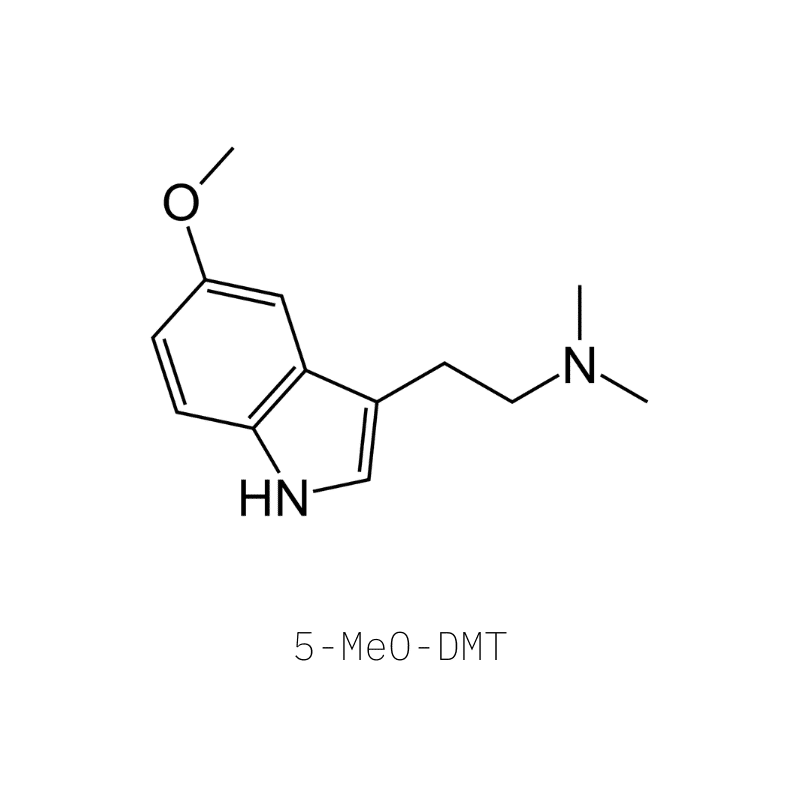
How to Synthesize 5-MeO-DMT
Synthesizing 5-MeO-DMT is harder than extracting it from plants and requires some more advanced lab equipment. With that said, it’s still a relatively simple process that can be performed safely and effectively by people with a basic understanding of chemistry and lab techniques.
Hamilton Morris released a video earlier in 2021 that essentially highlights a modified version of the Eschweiler−Clarke reaction using 5-methoxy-tryptamine as the starting material (already legal and commercially available).
The reaction is very simple, involving a complete transformation with just one reaction.
Once the 5-MeO-DMT is created, it’s purified, purified again, and tested.
Ingredients:
- 5-Methoxy-Tryptamine
- Methanol
- Potassium Hydroxide
- Formaldehyde
- Sodium cyanoborohydride
Equipment:
- Reflux condenser
- Reaction chamber
- Rotary Evaporator
- Thermometer
- Two addition funnels
The Process: Simplified
- Slowly mix 5-methoxy-tryptamine with formaldehyde and sodium cyanoborohydride
- Skim off the 5-MeO-DMT that floats to the top
- Purify through distillation and recrystallization
- Test the final sample
Step-By-Step Process:
The easiest way to make 5-MeO-DMT is to find a source of raw 5-MeO-tryptamine freebase — a compound that’s entirely legal and available from chemical retailers or wholesalers. The price of this stuff varies a lot depending on where you live.
Step 1: Dissolve the 5-methoxy-tryptamine free base in methanol
The first step is to dissolve the powdered 5-MeO-tryptamine in methanol or another solvent to facilitate the reaction. This compound is readily available (legally), where it’s most commonly used to make melatonin. This molecule requires a simple reduction reaction to become 5-MeO-DMT.
Step 2: Cool the Mixture to 0ºC
Using an ice bath or chiller, the reaction vessel and the 5-MeO-tryptamine are cooled to 0ºC.
Step 3: Slowly Combine Formaldehyde and Sodium cyanoborohydride
Using two addition funnels, slowly combine the reducing agents into the reaction vessel. These elements should be added slowly while constantly stirring.
Step 4: Evaporate the Methanol
Gently heat the mixture overnight to evaporate the methanol. As the methanol evaporates, 5-MeO-DMT “oil slicks” form on the surface of the liquid.
Step 5: Purify the 5-MeO-DMT
Now that the 5-MeO-DMT is created, it needs to be separated from the rest of the elements in the mixture. Distillation removes the water, short-path vacuum distillation concentrates the crude DMT freebase. The final step is to recrystallize the 5-MeO-DMT by redissolving the crude extract with warm methanol and then leaving it in the fridge for a few hours to form crystals on the bottom of the container.
The mixture is then filtered, dried, and tested for purity.
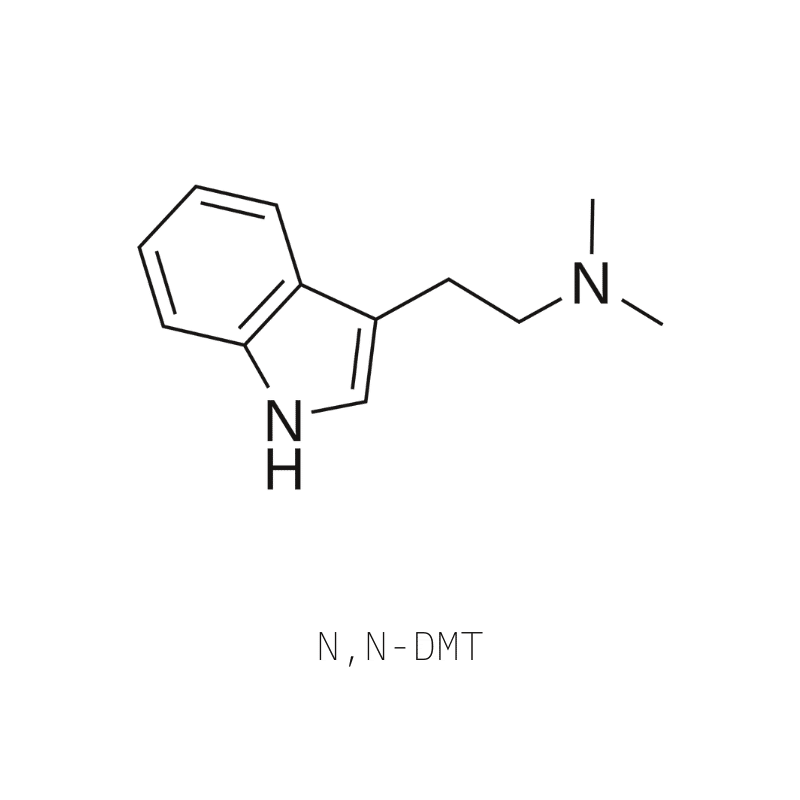
How to Synthesize N,N,DMT
Synthesizing N,N,DMT is the most difficult of the three methods and requires a much higher degree of skill and experience to perform safely and efficiently.
Additionally, the chemicals needed to run the extraction are harder to obtain and are highly flammable, caustic, and toxic.
Ingredients:
- Oxalyl chloride
- Diethyl ether
- Lithium aluminum hydride
- Ether
- Distilled water
- Tetrahydrofuran
- Dioxane
- Anhydrous magnesium sulfate
- Petroleum Ether
- Hydrogen chloride
Equipment:
- Reflux condenser
- Reaction vessel
- Separation filter
The Process: Simplified
- Dissolve Tryptamine with Diethyl Ether
- React with reagents to form N,N,DMT
- Form the DMT Salt
- Recrystallize & Remove All Solvents
- Test the Final Product
Step-By-Step Instructions for Synthesizing N,N,DMT
The following method was outlined by Alexander Shulgin in his book, PIHKAL. This process requires some experience in a lab and access to several pieces of lab equipment in order to perform safely.
Step 1: Dissolve Tryptamine With Diethyl Ether
The first step is to dissolve the precursor for N,N,DMT — tryptamine — with diethyl ether. Stir it around for several minutes to ensure all the tryptamine is dissolved.
Step 2: Combine Tryptamine Solution With Oxalyl Chloride
Next, add the oxalyl chloride, which acts as a reagent to form indole oxalyl chloride — an intermediary between the starting material (tryptamine) and the final product (N,N,DMT). This reaction will form a yellow crystalline substance that falls out of solution on the bottom of the container.
Step 3: Add Dimethylamine
A compound called dimethylamine is then added to react the indole oxalyl chloride. This forms the next chemical intermediary called indol-3-yl-N,N-dimethyloxylamide.
Stir the solution for several minutes until a white precipitate forms at the bottom of the container.
Step 4: Remove the White Substance From the Liquid
Filter the entire mixture to remove the white substance from the container. Wash it with ether and water to remove all the diethyl ether from the substance and let it dry in a well-ventilated area.
Step 5: Add Lithium Aluminum Hydride
Create a solution of lithium aluminum hydride in tetrahydrofuran and add the white powder you obtained from step 4.
Reflux the entire solution for several hours and allow it to cool to room temperature. You’ll need to add some dioxane to eliminate any excess hydroxide leftover from the reaction. The resulting mixture should result in a white sediment forming at the bottom of the reaction vessel — which contains the DMT and several impurities that need to be removed.
Step 6: Filter, Wash, & Dry
Filter the mixture to remove the white DMT-containing powder. Rinse it with tetrahydrofuran several times and dry the powder using anhydrous magnesium sulfate.
Step 7: Recrystallize The Impure Powder
The powder you’re left with at this point contains a high concentration of DMT — but it isn’t pure. It needs to be purified before it’s safe to use.
Dissolve the powder in a solvent such as petroleum ether and slowly heat the solution until the powder is completely dissolved. Allow the solution to cool to room temperature to allow the DMT chrystals to form. You may need to place the solution in the fridge to get the DMT to fall out of solution.
Filter the powder and allow it to air-dry in a well-ventilated space. You still don’t have pure DMT at this point.
Step 8: Create DMT Salt
Combine the powder with diethyl ether (anhydrous) and hydrogen chloride (anhydrous). This forms N,N,DMT hydrochloride, the final product of this reaction. It’s a DMT salt that’s going to remain stable long-term. Filter and allow the powder to dry.
Step 9: Recrystallize Once More
Add the powder to methanol or benzene while gently heating. Once all the powder is dissolved, remove from heat and allow it to cool. DMT hydrochloride will gradually start to crystallize in the container, which can then be filtered and air-dried for the final time.
The final product is (nearly) pure N,N,dimethyltryptamine hydrochloride.
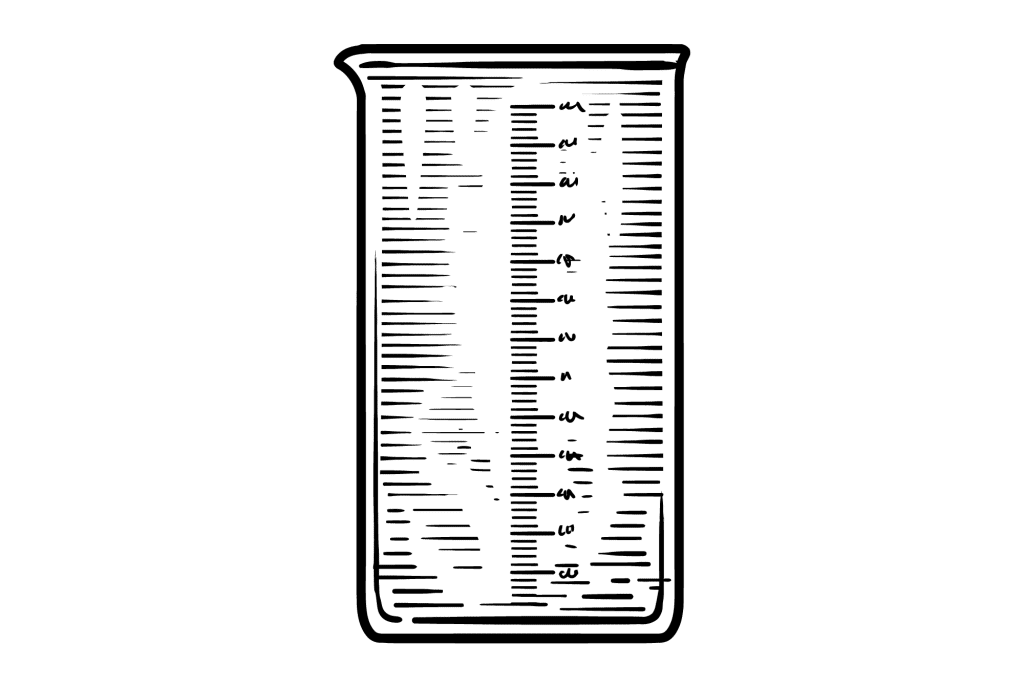
IMPORTANT: Lab Safety
Making DMT isn’t overly complicated, but its production involves the use of highly flammable and toxic ingredients. It’s critical that anybody attempting to make this substance is familiar with the dangers and how to minimize the level of risk involved.
Even in a fully-equipped laboratory, mistakes can (and do) result in explosions, fires, and potentially lethal exposure to toxic chemicals.
Here are some important considerations to keep in mind whenever working in a lab:
1. Always Wear Gloves & Safety Goggles
Many of the chemicals involved in the process of extracting or synthesizing DMT are either caustic (causes chemical burns), toxic, or flammable — all three of those reasons are perfectly good excuses for wearing protection to avoid accidental harm.
While you may feel these safety steps aren’t important because you’ve “never had an incident before,” — this is a logical fallacy you don’t want to learn the hard way. Just because you’ve gone without incident in the past doesn’t mean it can’t happen in the future.
Getting any of these chemicals in the lungs, on the skin, or in the eyes can cause permanent damage.
2. Ensure You Have Adequate Ventilation
Solvents like naphtha are highly flammable. Some of the steps involve heating these ingredients, which causes them to evaporate into the air. If there isn’t adequate airflow to remove these compounds as they evaporate, they may be inhaled (toxic) or reach a spark or flame to cause an explosion and resulting fire.
It’s best to perform these reactions in a workshop with HVAC systems installed, or at the very least with the garage door cracked open and a fan blowing air from inside the garage to the outside.
3. Understand the Chemicals You’re Using
Some of the chemicals on the recipe lists above can be found in over-the-counter chemicals like Draino. However, these cleaning agents aren’t pure. The other additives could be toxic or result in the production of unknown toxic byproducts.
You should always use lab-grade chemicals whenever possible and understand the process you’re following before you begin.
4. Never Heat Your Solvents With an Open Flame
In a similar vein as point number two, if any of the solvents that evaporate into the air reach an open flame or spark (including static electricity), they could trigger a fire. Before you begin, make sure there are no sources of open flame (such as a heater or stovetop), don’t smoke, don’t use your vaporizer — nothing.
5. Test Your Final Product Before You Use It
Even the best chemists in the world test the final product to ensure it’s pure. While people performing DIY extractions in their garage probably won’t have access to a mass spectrometry machine, there are other, more crude methods of ensuring the final products are what they think they are.
Order yourself some reagent harm-reduction kits to test a sample of your product when you’re done. This won’t prove the purity of the final product, but it will ensure that you didn’t miss the mark entirely and end up with something completely different.
The Chemical Structure of DMT
DMT is classified as an indole alkaloid — which is the same classification for many psychedelic compounds, including LSD (lysergic acid diethylamide) and psilocybin (magic mushrooms). It’s also the base structure for the amino acid tryptamine, as well as serotonin and melatonin.
There are over 4000 different indole alkaloids in existence; many of them are pharmacologically active in humans.
The base structure of all indole alkaloids is a combination of a 6-sided benzene ring fused to a 5-sided pyrrole ring.
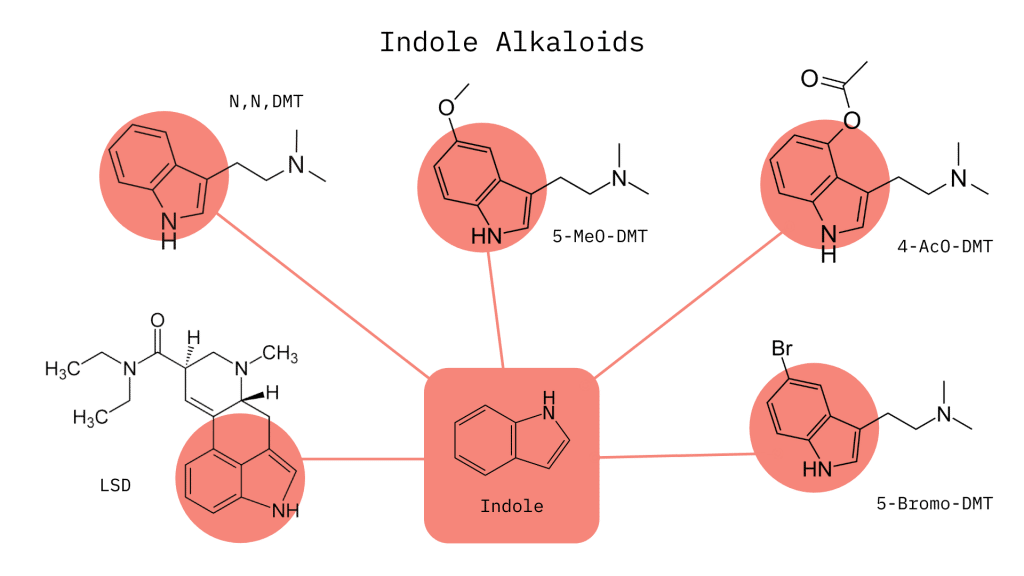
The DMT molecule itself is one of the simplest psychedelics known. Its molecular weight is only slightly higher than glucose. Its small size allows it to cross the blood-brain barrier much more easily than other psychedelics.
The History of DMT Production
The first form of DMT extraction comes from the Amazon in the form of ayahuasca. The ayahuasca brew is essentially a water extract of DMT from local plant species, as well as a series of harmala alkaloids from the ayahuasca vine (Banisteriopsis caapi).
The first time N,N,DMT was synthesized in a lab was in 1931 by the Canadian chemist Richard Helmuth Frederick Manske. At the time, Manske had no idea the chemical he created had psychedelic effects.
Later, in 1946, Brazilian chemist Oswaldo Gonçalves de Lima isolated N,N,DMT from the bark of Mimosa hostilis.
Today, there have been dozens of studies highlighting new techniques or innovations on the production of synthetic DMT as well as its extraction.
Large-Scale DMT Production
The methods outlined above are the easiest ways to make DMT, but they aren’t necessarily the most efficient on a large scale.
An article published in late 2020 did a great job at summarizing the methods used to synthesize 5-MeO-DMT at scale. These methods optimize the potency and consistency of production from one batch to another, rather than optimizing for cost-reduction or simplicity.
This report outlined three methods for synthesizing 5-MeO-DMT from different starting materials:
1. Modified Eschweiler−Clarke Reaction
- Single-step reaction
- Simple process
- Difficult to scale
This method is the single-step process outlined above, as well as by Hamilton Morris in his demonstration of 5-MeO-DMT synthesization.
It’s relatively easy to use but relies on access to 5-MeO-tryptamine as the starting material — which is currently legal and readily available commercially. Most of the hard work has already been done creating the precursor, so a simple reduction reaction is needed to convert the molecule into 5-MeO-DMT.
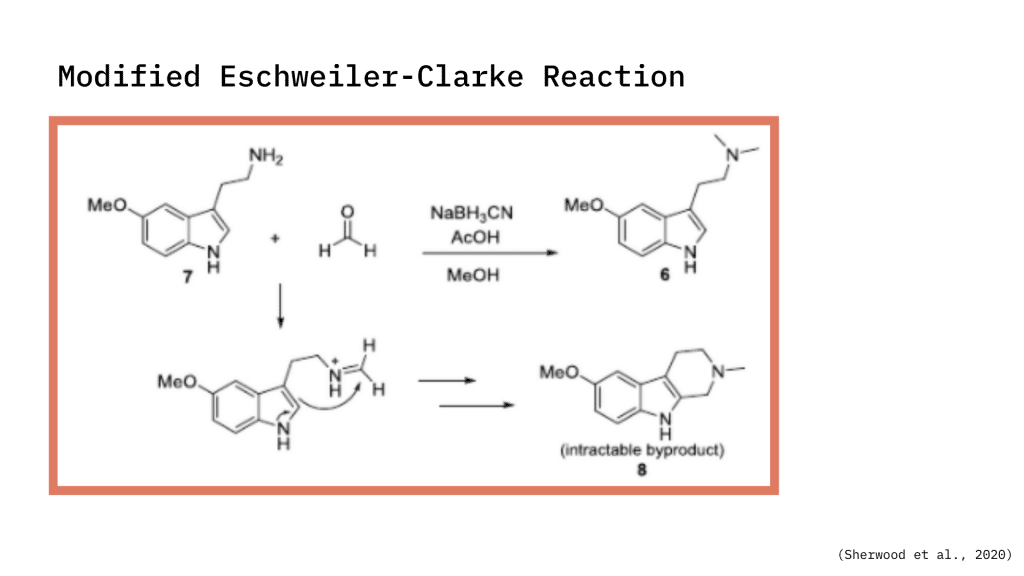
2. The Speeter−Anthony Tryptamine Synthesis
- >90% conversion efficiency
- Difficult to scale
- Requires oxygen-sensitive ingredients
This method is the most common process cited in the academic literature. It’s used to make a variety of psychedelic tryptamines, including psilocybin and psilocin. This process is being phased out in favor of the Fischer indole reaction because it’s easier to scale.
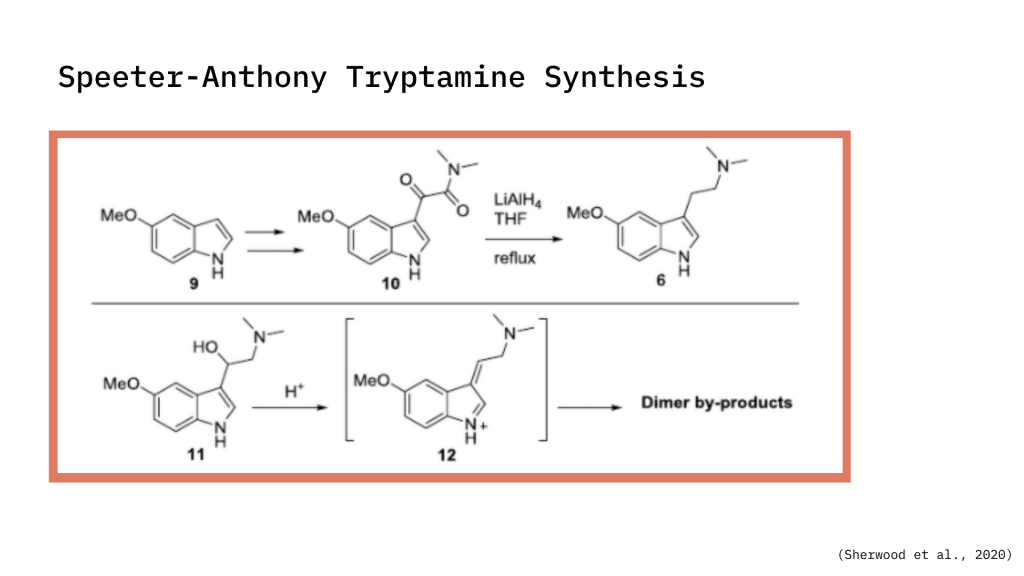
3. The Fischer Indole Reaction
- 80% conversion efficiency
- Single-step process
- No high temperatures
- Occurs in aqueous solvent
- Can be used for both 5-MeO-DMT and N,N,DMT
This process is considered the best process for large-scale production because it’s scaleable, involves just one reaction step, doesn’t require high temperatures (less dangerous), occurs in an aqueous solvent, doesn’t require the use of air-sensitive or pyrophoric reactants, and uses simple, readily available ingredients.
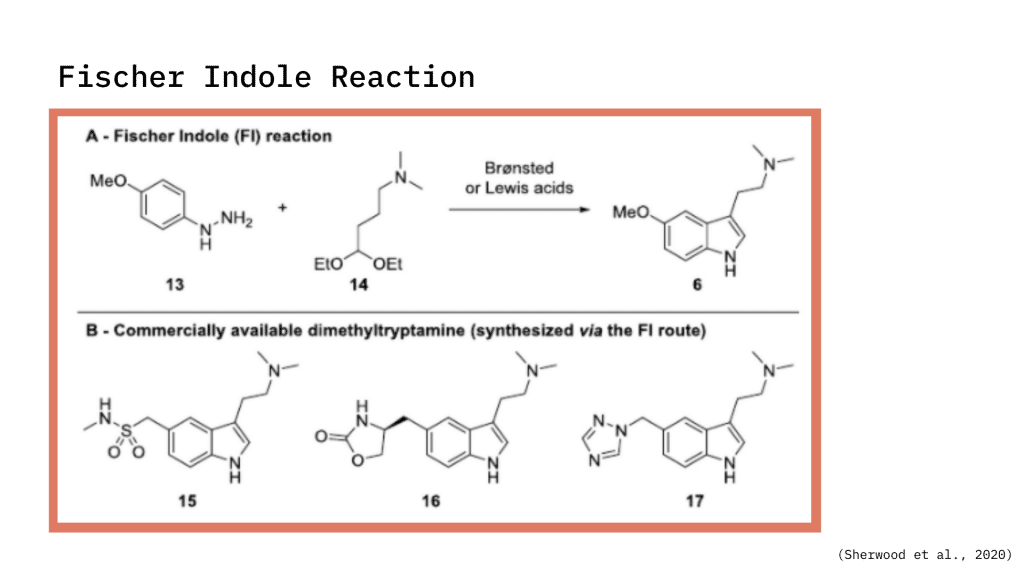
How to Use DMT
The DMT yielded by the processes outlines above leaves you with a fine, white to brownish powder. Here’s how to use freebase DMT powder:
1. Vape It
Vaporizing DMT is the simplest method of using it. There are two main ways to do this:
Make a DMT-charged E-Liquid — dissolve the powder into an E-liquid base (readily available online) and then fill an E-liquid vape pen with the DMT-charged E-juice. You can make the juice as strong as you want, but the most common ration is 1:1. This means you should add about 1 gram of DMT powder for every 1 mL of E-liquid.
Vape raw DMT powder in a mesh or mod vape pen — These devices contain a stainless steel mesh that holds the powder above the heating element. This is the best method for single-hit breakthroughs. The downside is that these devices are more expensive and take some finessing to get them to work properly.
2. Smoke It
DMT can be smoked in a pipe or bong. It’s going to be very harsh no matter how you smoke it. Some people like to use the crack-style pipes to smoke DMT because they can control the temperature of it better than having to put the flame on it directly.
Never use DMT powder without weighing it first. This stuff is exceptionally strong.
3. Eat It
If you eat DMT powder directly, nothing will happen. You need to mix it with a monoamine oxidase inhibitor first for it to work.
This is some tricky business and not something anybody should attempt without adequate knowledge and oversight from experienced users. There are two categories of MAO inhibitors to consider — herbal MAO inhibitors and pharmaceutical MAO inhibitors.
The preparation most people use for this is called pharmahuasca. The concept simulates ayahuasca using synthetic ingredients. This means mixing DMT with a prescription MAO inhibitor like Isocarboxazid (Marplan). This combination can be dangerous — Marplan is a powerful drug with a long list of potential side effects.
Herbal options include Syrian Rue and Ayahuasca vine. They can be made into a very strong tea and mixed with DMT. The experience using this method will range substantially from being not psychoactive at all to powerfully psychoactive.
Final Thoughts: How to Make DMT
Making DMT is easier than you might expect. The simplest method is to extract and concentrate it from plants, but it can also be synthesized using relatively simple chemistry.
In theory, a single lab could produce enough DMT to supply the entire continent. Processes are currently being explored that produce 5-MeO-DMT and N,N,DMT at an efficiency of over 80%.
It’s important we set the standard for DMT production early before it gets out of control. Looking back at history, when substances become popular, all sorts of unethical players enter the space. These manufacturers may not hold the same level of integrity over their manufacturing process as we need. This could result in harmful, adulterated, or low-quality DMT entering the marketplace.
